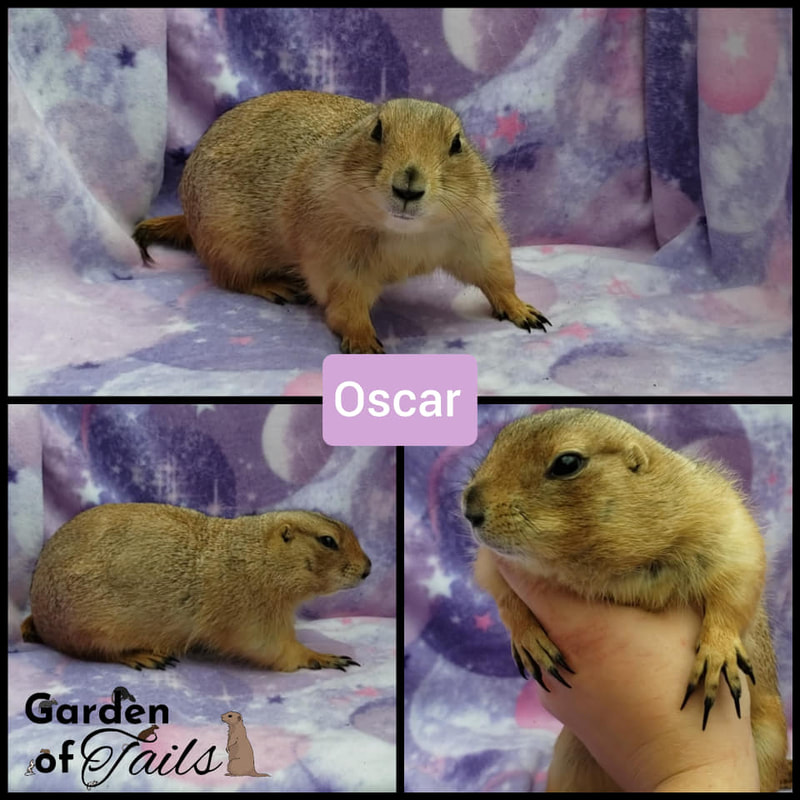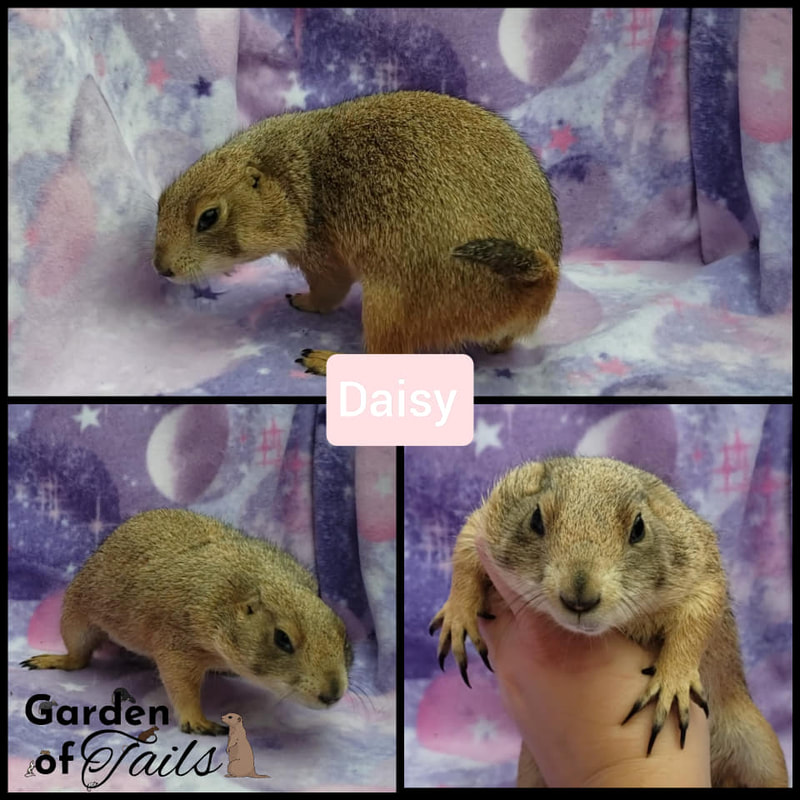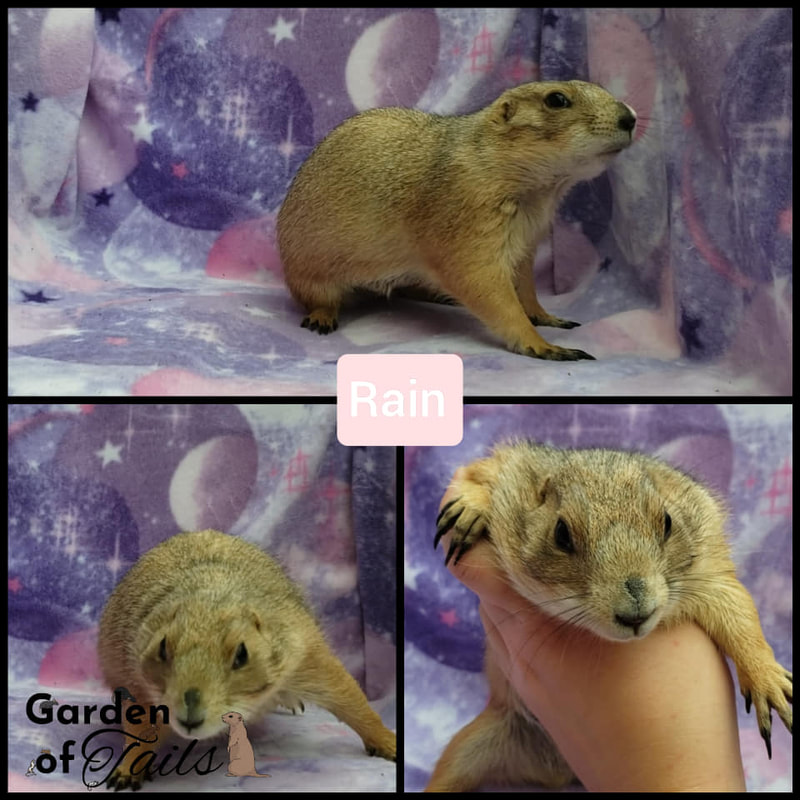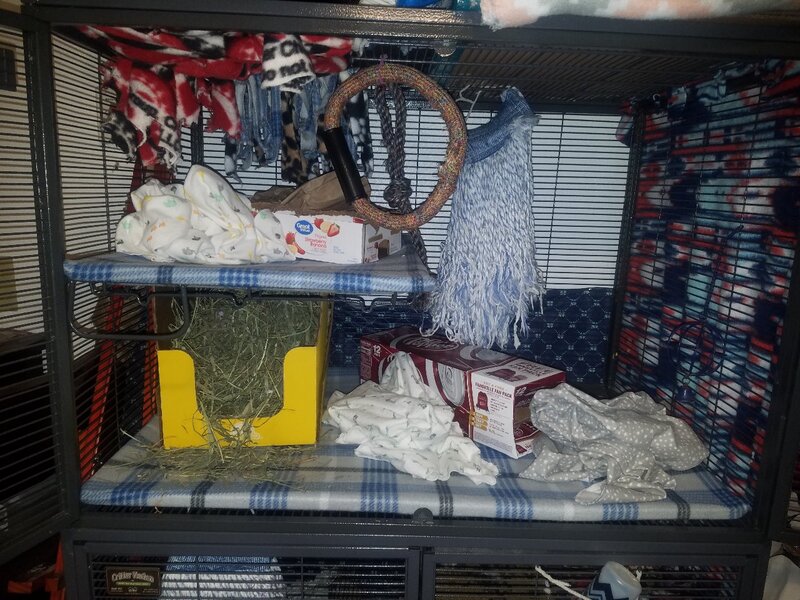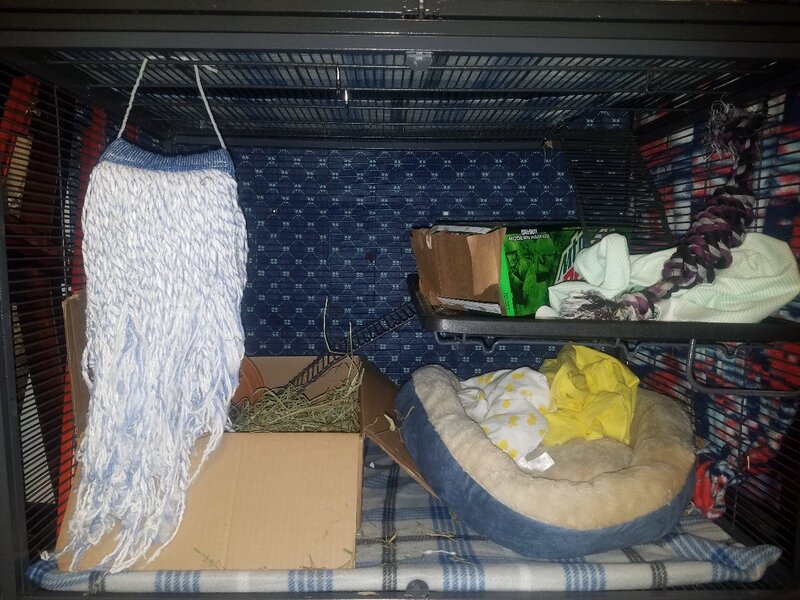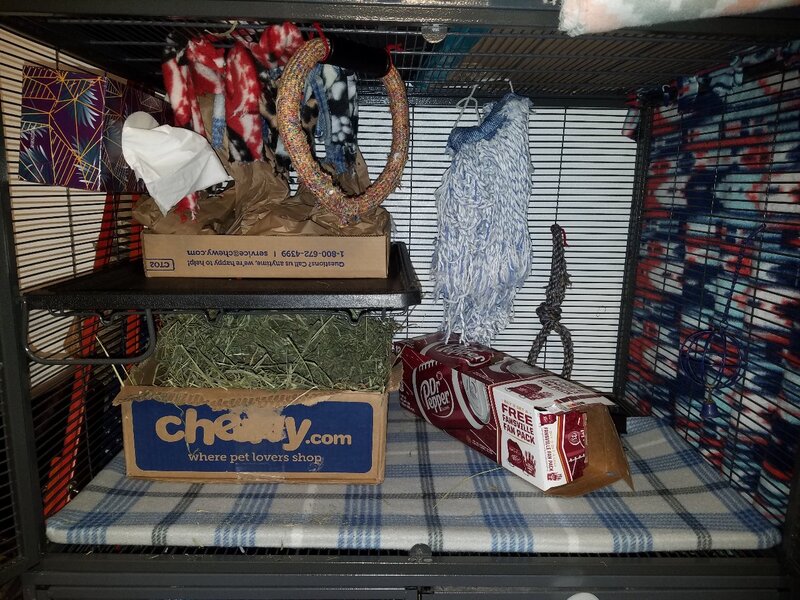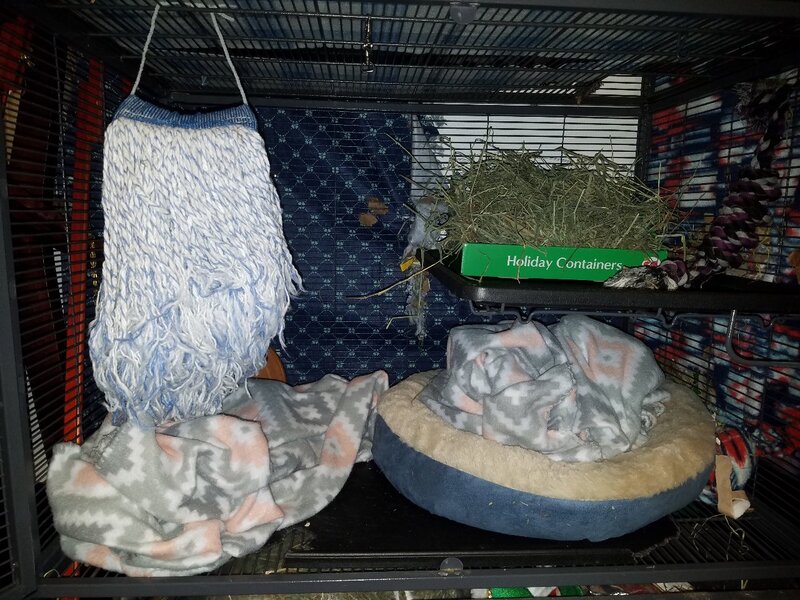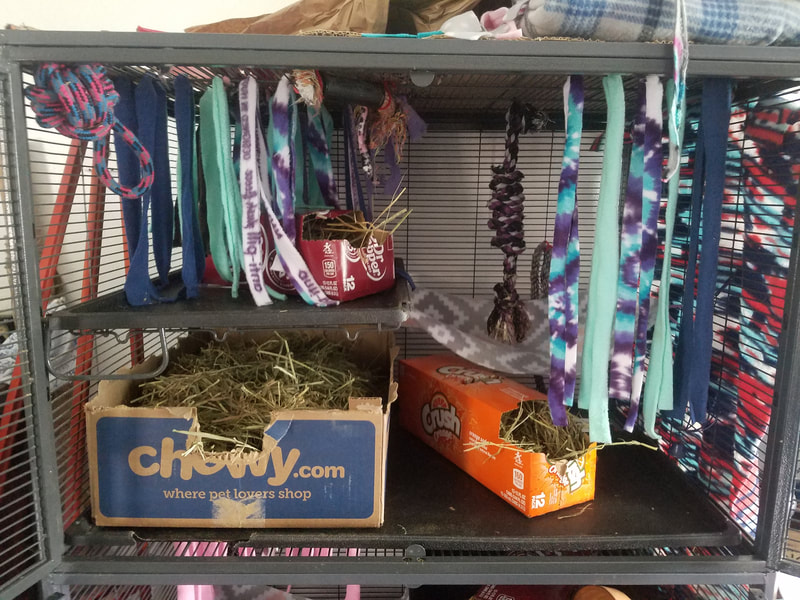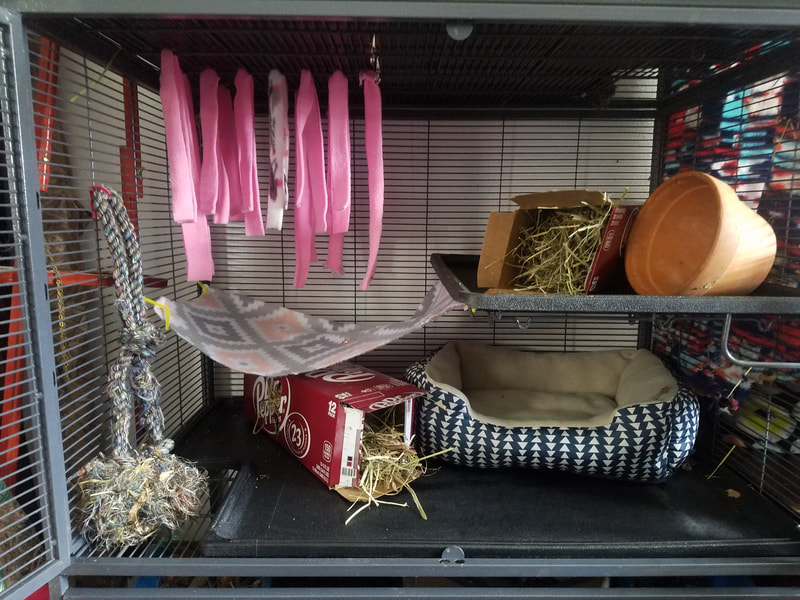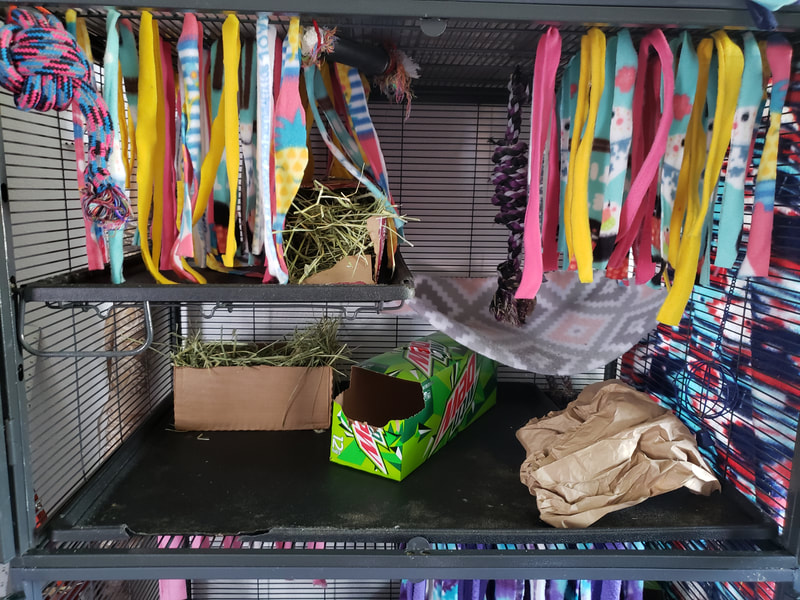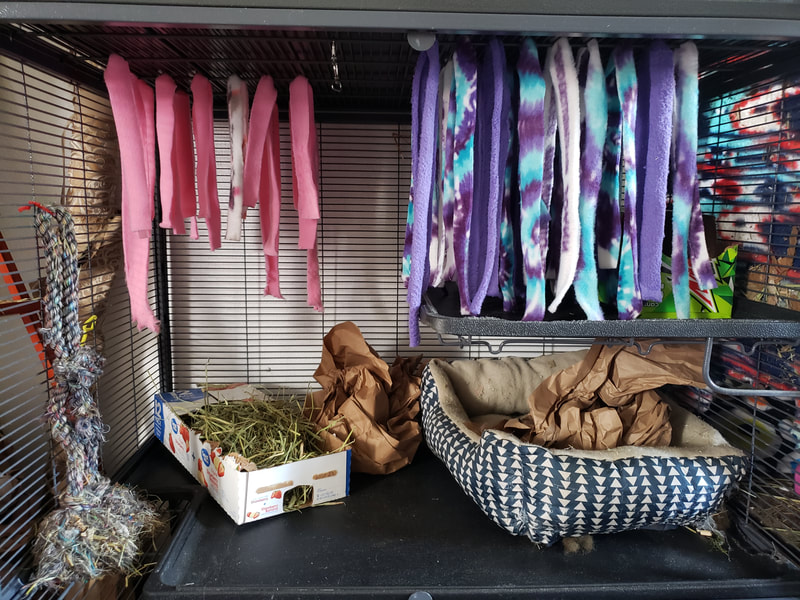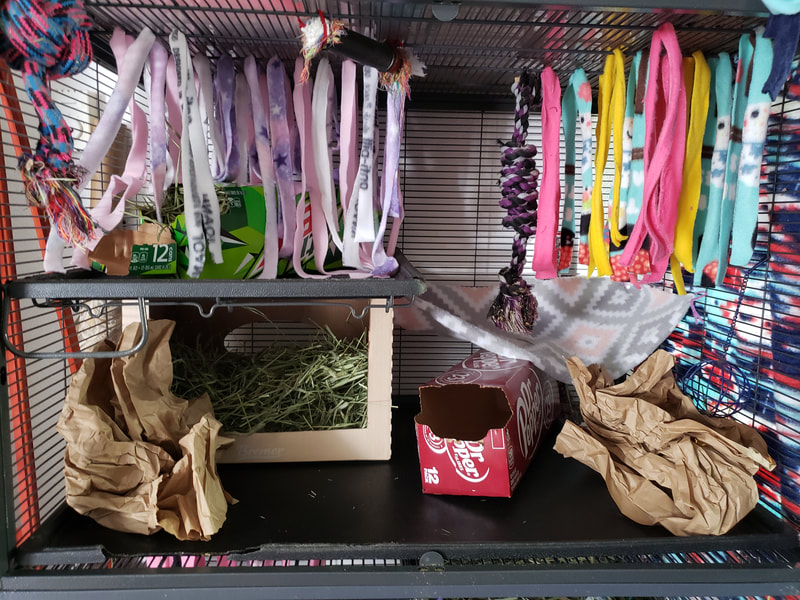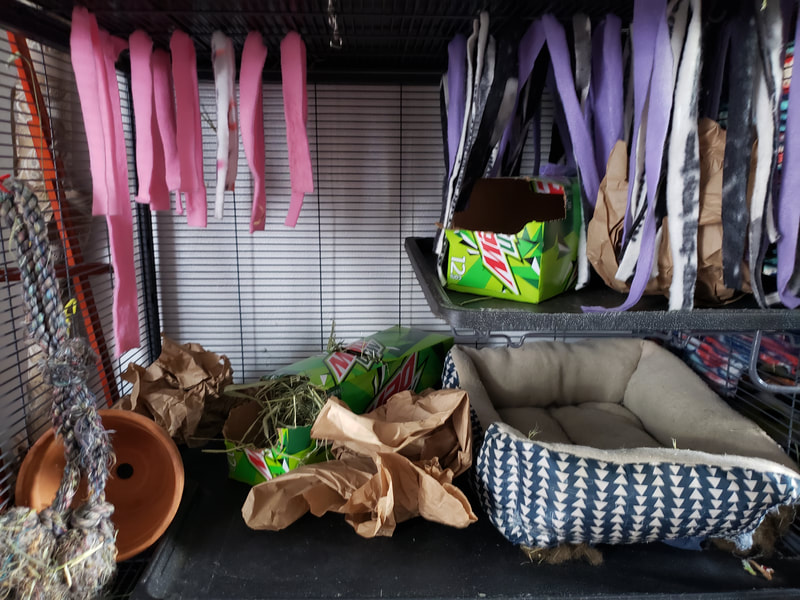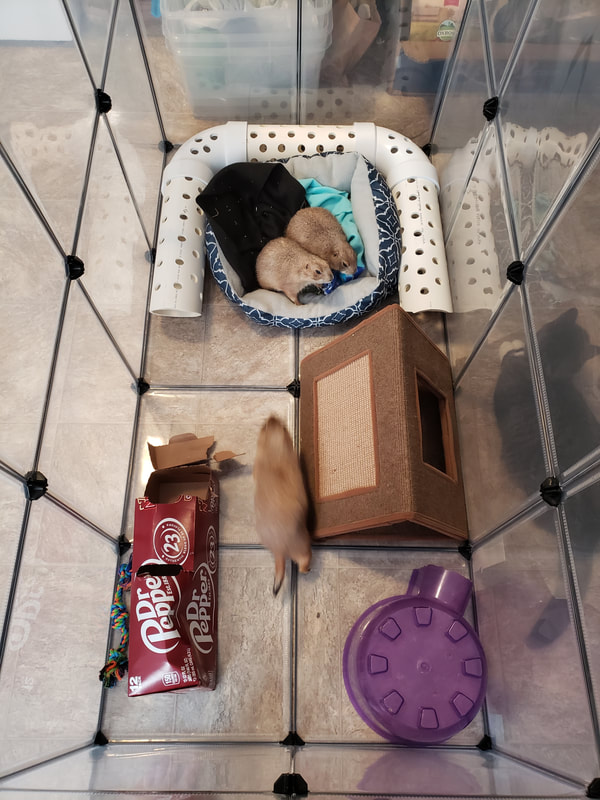My Prairie Dogs
Are prairie dogs good pets?
You may be wondering, "do these guys make good pets?" The simple answer, no. While I love having them, they are definitely hard pets to keep up with, and are very different from your typical caged pets. While they are rewarding, and I wouldn't trade them for the world, I'm not sure that I'll have more prairie dogs after these guys. They are definitely not recommended for elderly or family with children. Prairie dogs are wild animals and can be unpredictable. They are also extremely destructive! Follow the Facebook group, Prairie Dog Parents, for ideas on how to "proof" your house or room they are in. Otherwise, say goodbye to your carpet, furniture legs, wall trim, etc!
If you'd like more information on them, please see below, and join Prairie Dog Parents on Facebook!
If you'd like more information on them, please see below, and join Prairie Dog Parents on Facebook!
Basic Information:
- Diet: This is about the most simple aspect of prairie dogs. Their diet consists of few items that are pretty easy to access. Foods outside of this list are best avoided due to them being prone to obesity. They will try to make it seem like they've never eaten, and will pretty much eat anything they can get their hands on, whether it be good for them or not.
* Always provide fresh timothy hay! It's best to provide 3x their body size in hay daily. They are selective eaters and will not eat most of what they are given. Extra hay can be given to other animals like guinea pigs, rabbits, degus, or other hay eating animals to avoid waste. It's also great for compost if you have a compost pile. They also like to sit in their hay while they eat, so it is recommended to put the hay in a cardboard box or other container. The brand of hay does not matter, but it's best to avoid overly dusty brands. I personally buy the bulk 50lbs bale from Oxbow.
* Pellets; either Oxbow Adult Rabbit pellets or American Pet Diner Prairie Dog Natural. These are the only two suitable pellet foods for prairie dogs. Other brands labeled for prairie dogs are not balanced correctly, and can cause health issues. Young prairie dogs (under 2lbs) will need 1/4 cup of pellets daily. Adults only need 1/8 cup daily. 95% of their diet should be timothy hay. I personally use Oxbow Adult Rabbit Pellets.
*Protein: dried meal worms are best! Live meal worms can be given occasionally, but they are too high in fat to be used as their main source. Young prairie dogs (under 2lbs) need 1tsp of dried meal worms daily to keep up with how quickly they grow. Adults only need 2-3 dried meal worms daily. Some sources recommend 1tsp weekly, but having bursts of protein, and the lack of for the rest of the week, can cause protein deficiencies. I personally experienced this, and was then recommended giving meal worms daily, instead of weekly for my adults. I've not had any issues since I've done this!
* Fresh Foods: 1 baby carrot or 1 piece of sweet potato the size of a baby carrot daily. I personally do baby carrots as that's what my prairie dogs prefer.
* Treats: Should not exceed 1/8 cup (pellets included in this amount) of their daily diet
Kale, romaine lettuce, whole oats/rolled oats, edamame beans, prickly pear cactus, fresh corn kernels (NEVER dried corn), cheerios (plain), shredded wheat cereal (plain) (NOTE: Too many Wheaties/cheerios may cause crystals to form in kidneys.) **List taken from PDP recommendations**
I grow my own kale for my animals, and give them a leaf off of it every few weeks instead of a carrot.
* Food to Avoid:
Processed foods including but not limited to: Chips, pizza, cheese, ice cream, chocolate, sweets, candies, dried corn, spinach, tomato, lettuce, oily foods, rodent blocks, gerbil/hamster food, parrot food, other foods formulated for other species, alfalfa, and fruits
* Water: Fresh water should always be provided. Distilled water is best avoided. Water dishes should be avoided as well, as they can drown themselves in water bowls/dishes. Small animal water bottles with metal nozzles are best used. I personally put ACV (apple cider vinegar with "mother") in their water. This helps with smell. However, doing this, you will need to clean their bottle weekly to avoid bacterial growth. The measurement is 1tbs per gallon of water.
Tips:
- Hand feed carrots and meal worms to help bond with your prairie dog.
- Some prairie dogs can be overly excited about meal worms, which can cause them to dig and nip at your fingers when they're gone. The best method I've found to feed their meal worms is to hand them their carrot first, then hand them their meal worms while they're eating their carrot. That way, when they are done eating their meal worms, they have the carrot to distract them, as "oh, more food!"
- Scatter their pellet food in their hay. This encourages natural foraging for the pellets and makes them have to work for their food.
- Be sure to remove old hay before giving fresh hay. Keeping in the old hay will encourage them to nest with the new hay rather than eat it.
- Use a baby bottle brush to clean their water bottle (if you use ACV) and a q-tip to clean the nozzle.
* Always provide fresh timothy hay! It's best to provide 3x their body size in hay daily. They are selective eaters and will not eat most of what they are given. Extra hay can be given to other animals like guinea pigs, rabbits, degus, or other hay eating animals to avoid waste. It's also great for compost if you have a compost pile. They also like to sit in their hay while they eat, so it is recommended to put the hay in a cardboard box or other container. The brand of hay does not matter, but it's best to avoid overly dusty brands. I personally buy the bulk 50lbs bale from Oxbow.
* Pellets; either Oxbow Adult Rabbit pellets or American Pet Diner Prairie Dog Natural. These are the only two suitable pellet foods for prairie dogs. Other brands labeled for prairie dogs are not balanced correctly, and can cause health issues. Young prairie dogs (under 2lbs) will need 1/4 cup of pellets daily. Adults only need 1/8 cup daily. 95% of their diet should be timothy hay. I personally use Oxbow Adult Rabbit Pellets.
*Protein: dried meal worms are best! Live meal worms can be given occasionally, but they are too high in fat to be used as their main source. Young prairie dogs (under 2lbs) need 1tsp of dried meal worms daily to keep up with how quickly they grow. Adults only need 2-3 dried meal worms daily. Some sources recommend 1tsp weekly, but having bursts of protein, and the lack of for the rest of the week, can cause protein deficiencies. I personally experienced this, and was then recommended giving meal worms daily, instead of weekly for my adults. I've not had any issues since I've done this!
* Fresh Foods: 1 baby carrot or 1 piece of sweet potato the size of a baby carrot daily. I personally do baby carrots as that's what my prairie dogs prefer.
* Treats: Should not exceed 1/8 cup (pellets included in this amount) of their daily diet
Kale, romaine lettuce, whole oats/rolled oats, edamame beans, prickly pear cactus, fresh corn kernels (NEVER dried corn), cheerios (plain), shredded wheat cereal (plain) (NOTE: Too many Wheaties/cheerios may cause crystals to form in kidneys.) **List taken from PDP recommendations**
I grow my own kale for my animals, and give them a leaf off of it every few weeks instead of a carrot.
* Food to Avoid:
Processed foods including but not limited to: Chips, pizza, cheese, ice cream, chocolate, sweets, candies, dried corn, spinach, tomato, lettuce, oily foods, rodent blocks, gerbil/hamster food, parrot food, other foods formulated for other species, alfalfa, and fruits
* Water: Fresh water should always be provided. Distilled water is best avoided. Water dishes should be avoided as well, as they can drown themselves in water bowls/dishes. Small animal water bottles with metal nozzles are best used. I personally put ACV (apple cider vinegar with "mother") in their water. This helps with smell. However, doing this, you will need to clean their bottle weekly to avoid bacterial growth. The measurement is 1tbs per gallon of water.
Tips:
- Hand feed carrots and meal worms to help bond with your prairie dog.
- Some prairie dogs can be overly excited about meal worms, which can cause them to dig and nip at your fingers when they're gone. The best method I've found to feed their meal worms is to hand them their carrot first, then hand them their meal worms while they're eating their carrot. That way, when they are done eating their meal worms, they have the carrot to distract them, as "oh, more food!"
- Scatter their pellet food in their hay. This encourages natural foraging for the pellets and makes them have to work for their food.
- Be sure to remove old hay before giving fresh hay. Keeping in the old hay will encourage them to nest with the new hay rather than eat it.
- Use a baby bottle brush to clean their water bottle (if you use ACV) and a q-tip to clean the nozzle.
- Housing: Prairie dogs need specific housing requirements to prevent health issues. Unlike many other rodents, prairie dogs cannot chew on metal or hard woods. Chewing on hard items can cause odontoma (trauma to their teeth, which can be fatal). To prevent chewing, be sure to get a cage with 1/2" bar spacing or less. Also, provide lots of enrichment items to keep them from being bored. This will curb chewing.
If your prairie dog has developed a chewing habit, IGNORE THEM! Giving them attention, saying no, hitting the cage to get them to stop, etc, will only encourage them to keep chewing. The best thing you can do for them is to ignore. Prairie dogs are OCD animals though, so if the habit continues, when they are not chewing, place something in the spots the most frequently chew. Items can include, but are not limited to, rope toys, weaving fleece fabric through the bars, cardboard, or plexiglass on the outside of the cage.
Prairie dogs chew because they are bored and want attention. Be sure you are allowing plenty of outside the cage time, as well as interacting with them. These guys love, love, love, attention, and crave it. If they feel they have not gotten enough attention, they may resort to chewing on their cage.
*Recommended cages: Attached is a link from the Facebook group, Prairie Dog Parents. It goes over good and bad cages for prairie dogs. They also have lots of other great resources on their Files tab! I personally have the Double Critter Nation cage for my three prairie dogs. This link also goes over housing young prairie dogs before putting them in Critter Nation, or other suitable, cages.
Link: https://lookaside.fbsbx.com/file/Prairie%20Dog%20Cages.pdf?token=AWzMNGhA2fMDch1oD0BAX0FChqeDynoYBQyOvzeGRdM0gUxJfr6Z5BB4VU-yj0TwU3Xx9a5jrMkJIiiKWI8tocVp0rTKOPcMp0SHiywvPDy7uNh29W_qmwXnSE9PGUg-cJbRrGEpuDVtM_ZFIF6ZDP-Q-3K-oncp7z7lec4kCj7GnoEXrgHdCWRiQKpoI0YWXT-pRxxSPApkiETXlvirWH7JWg0CmT6V-_Jtyl-onF21qkHJ-x5N9Gk1lTCbD6IPlEdCI9cE1NqMmsm9PCa8Bng6Jgkt6cdXiH-gAI5F7xzZcA
* Play Pen: Linked is the recommended play pen for prairie dogs. This one provides a solid bottom and sides they cannot climb. Play pen time should be supervised in case they do manage to find a way out. Prairie dogs are notorious for getting into tight spaces, or even in walls. You will need to purchase two of these to stack on top of each other. One of the pens isn't tall enough, and they will jump out of it.
Link: https://www.amazon.com/gp/product/B07FQ411ZH/ref=ppx_yo_dt_b_asin_title_o02_s00?ie=UTF8&psc=1
Tip: Be sure to have the "seam" of the pen on the outside of the pen. Otherwise, they'll be able to get their teeth on it and pull it up. The bottom and sides of the pen should be completely smooth.
* Enrichment Ideas: (Photos of cage setups below)
Some of the most common items I used to fill my prairie dog cage are:
- tissue boxes (with tissues inside, but removed the plastic lining from the top),
- cardboard boxes (Amazon boxes, pop boxes, cereal boxes, etc.),
- cotton baby blankets (great for tunneling and packing into a nest shape),
- fleece scraps (hung from the tops of the cage),
- fleece hammocks (fleece from Wal-Mart's $2.50 variety blankets, cut into large rectangles)
- cat/small dog beds (I find cheap ones at Wal-Mart for $5. Some beds last longer than others)
- terracotta pots (they love to sit and sleep in these!)
- cotton mop heads (hang these from the tops of the cage)
- rope toys (smaller ones can be found at Dollar Tree, and larger ones at Wal-Mart, Menards, etc.)
- ChinSpin wheel (be sure to remove if they are running on it constantly. Too much running is unhealthy for them.)
* Items to avoid:
- wood chews, lava ledges, toys with metal parts, bells, and overall hard items
If your prairie dog has developed a chewing habit, IGNORE THEM! Giving them attention, saying no, hitting the cage to get them to stop, etc, will only encourage them to keep chewing. The best thing you can do for them is to ignore. Prairie dogs are OCD animals though, so if the habit continues, when they are not chewing, place something in the spots the most frequently chew. Items can include, but are not limited to, rope toys, weaving fleece fabric through the bars, cardboard, or plexiglass on the outside of the cage.
Prairie dogs chew because they are bored and want attention. Be sure you are allowing plenty of outside the cage time, as well as interacting with them. These guys love, love, love, attention, and crave it. If they feel they have not gotten enough attention, they may resort to chewing on their cage.
*Recommended cages: Attached is a link from the Facebook group, Prairie Dog Parents. It goes over good and bad cages for prairie dogs. They also have lots of other great resources on their Files tab! I personally have the Double Critter Nation cage for my three prairie dogs. This link also goes over housing young prairie dogs before putting them in Critter Nation, or other suitable, cages.
Link: https://lookaside.fbsbx.com/file/Prairie%20Dog%20Cages.pdf?token=AWzMNGhA2fMDch1oD0BAX0FChqeDynoYBQyOvzeGRdM0gUxJfr6Z5BB4VU-yj0TwU3Xx9a5jrMkJIiiKWI8tocVp0rTKOPcMp0SHiywvPDy7uNh29W_qmwXnSE9PGUg-cJbRrGEpuDVtM_ZFIF6ZDP-Q-3K-oncp7z7lec4kCj7GnoEXrgHdCWRiQKpoI0YWXT-pRxxSPApkiETXlvirWH7JWg0CmT6V-_Jtyl-onF21qkHJ-x5N9Gk1lTCbD6IPlEdCI9cE1NqMmsm9PCa8Bng6Jgkt6cdXiH-gAI5F7xzZcA
* Play Pen: Linked is the recommended play pen for prairie dogs. This one provides a solid bottom and sides they cannot climb. Play pen time should be supervised in case they do manage to find a way out. Prairie dogs are notorious for getting into tight spaces, or even in walls. You will need to purchase two of these to stack on top of each other. One of the pens isn't tall enough, and they will jump out of it.
Link: https://www.amazon.com/gp/product/B07FQ411ZH/ref=ppx_yo_dt_b_asin_title_o02_s00?ie=UTF8&psc=1
Tip: Be sure to have the "seam" of the pen on the outside of the pen. Otherwise, they'll be able to get their teeth on it and pull it up. The bottom and sides of the pen should be completely smooth.
* Enrichment Ideas: (Photos of cage setups below)
Some of the most common items I used to fill my prairie dog cage are:
- tissue boxes (with tissues inside, but removed the plastic lining from the top),
- cardboard boxes (Amazon boxes, pop boxes, cereal boxes, etc.),
- cotton baby blankets (great for tunneling and packing into a nest shape),
- fleece scraps (hung from the tops of the cage),
- fleece hammocks (fleece from Wal-Mart's $2.50 variety blankets, cut into large rectangles)
- cat/small dog beds (I find cheap ones at Wal-Mart for $5. Some beds last longer than others)
- terracotta pots (they love to sit and sleep in these!)
- cotton mop heads (hang these from the tops of the cage)
- rope toys (smaller ones can be found at Dollar Tree, and larger ones at Wal-Mart, Menards, etc.)
- ChinSpin wheel (be sure to remove if they are running on it constantly. Too much running is unhealthy for them.)
* Items to avoid:
- wood chews, lava ledges, toys with metal parts, bells, and overall hard items
- Spaying an Neutering:
Female prairie dogs no not need spayed. It's actually recommended to keep them intact, as the surgery can be a lot for them to recover from. However, the males MUST be neutered during their first or second summer. If they are not neutered by their second summer, at the latest, then they will go into rut during the winter. Winter/spring is their breeding season, and the males become extremely aggressive when they are not neutered. I've seen so many pictures and horror stories about people being attacked by their males without any warning due to them being in rut. They can and will send you to the ER.
Neutering isn't cheap, so be sure you have the funds set aside if you plan to get male prairie dogs. Oscar, my male, was neutered his first year, and it cost me a little over $200. I've seen double that be quoted at other vets though. If you are wanting males, be sure to call around your local exotic vets to get a quote before doing so!
- Hygiene:
Prairie dogs keep themselves clean, and do not require baths. It's not recommended to bathe them because it can irritate their skin. If they need a bath because they got into something they shouldn't have, like oil, paint, etc. use non-scented baby shampoo. Scents irritate their sensitive respiratory systems!
Prairie dogs also have extremely long, sharp claws for digging. It is best to avoid clipping their nails due to running the risk of cutting the bed of their nails. To help protect yourself from being scratched, wear thick, long sleeves, gloves, or toss a blanket over you while handling them.
- Common Health Issues: (Please see a vet if your prairie dog is displaying any odd symptoms. They are great at hiding illness, and don't typically show signs until they've had the issue for a while!)
* Odontoma: Commonly caused by chewing on hard surfaces such as metal (typically cage bars) or hard wood items. This causes the roots of their teeth to thicken or overgrow into their nasal cavities. Since prairie dogs only breathe through their nose, this can cause them to not get enough oxygen and suffocate. Trauma from chewing on hard surfaces doesn't typically show up for 1-2 years after it has happened. So, if you have a prairie dog that has a cage chewing habit, keep an eye out for symptoms, even if it's long after the chewing occurred.
* Symptoms can include: a sinus infection, loss of appetite, grunting, or a "stuffy" sounding nose, rubbing their nose a lot, gasping for air.
* Treatment: Odontoma can only be determined with an x-ray. Once identified, treatment could either be having their top teeth removed, or having an air "bypass" inserted. This is also known as a "blow hole" which allows them to breathe in and out of. If they have their top teeth removed, they will need to see the vet every 4-8 weeks for regular trimming for the remaining bottom teeth.
* Protein Deficiency: This is most common with young prairie dogs, but can occur in older PDs too. Protein deficiency is typically caused by inconsistent or not enough protein to keep up with the rapid growth of young prairie dogs. They should get 1tsp of dried meal worms daily. When it occurs in older prairie dogs, it is typically because they are not getting protein frequently enough. They should get 2-3 dried meal worms daily.
Young prairie dogs that are cold to the touch and/or sleep a lot, may have a protein deficiency. These are the same symptoms older PDs will show as well. If you notice this happening, the first step is to warm them up. This can be done by putting them under your shirt and rubbing them gently from head to rump. You can also get a warm water bottle, wrap it up, and keep it next to them to help maintain their body temperature.
Once you've warmed them up, offer food and water. If they are not drinking, it is recommend to syringe feed them Pedialyte or water immediately.
Other symptoms they can display are abnormal breathing. Be sure to check to make sure they are breathing normally. If they are not, then those can be signs of respiratory issues. The only way respiratory issues can be treated is by antibiotics given by the vet. If they are showing signs of respiratory distress, it is extremely important to get them to the vet as soon as possible. They hide symptoms well, and when they show, it means the infection has become severe.
Female prairie dogs no not need spayed. It's actually recommended to keep them intact, as the surgery can be a lot for them to recover from. However, the males MUST be neutered during their first or second summer. If they are not neutered by their second summer, at the latest, then they will go into rut during the winter. Winter/spring is their breeding season, and the males become extremely aggressive when they are not neutered. I've seen so many pictures and horror stories about people being attacked by their males without any warning due to them being in rut. They can and will send you to the ER.
Neutering isn't cheap, so be sure you have the funds set aside if you plan to get male prairie dogs. Oscar, my male, was neutered his first year, and it cost me a little over $200. I've seen double that be quoted at other vets though. If you are wanting males, be sure to call around your local exotic vets to get a quote before doing so!
- Hygiene:
Prairie dogs keep themselves clean, and do not require baths. It's not recommended to bathe them because it can irritate their skin. If they need a bath because they got into something they shouldn't have, like oil, paint, etc. use non-scented baby shampoo. Scents irritate their sensitive respiratory systems!
Prairie dogs also have extremely long, sharp claws for digging. It is best to avoid clipping their nails due to running the risk of cutting the bed of their nails. To help protect yourself from being scratched, wear thick, long sleeves, gloves, or toss a blanket over you while handling them.
- Common Health Issues: (Please see a vet if your prairie dog is displaying any odd symptoms. They are great at hiding illness, and don't typically show signs until they've had the issue for a while!)
* Odontoma: Commonly caused by chewing on hard surfaces such as metal (typically cage bars) or hard wood items. This causes the roots of their teeth to thicken or overgrow into their nasal cavities. Since prairie dogs only breathe through their nose, this can cause them to not get enough oxygen and suffocate. Trauma from chewing on hard surfaces doesn't typically show up for 1-2 years after it has happened. So, if you have a prairie dog that has a cage chewing habit, keep an eye out for symptoms, even if it's long after the chewing occurred.
* Symptoms can include: a sinus infection, loss of appetite, grunting, or a "stuffy" sounding nose, rubbing their nose a lot, gasping for air.
* Treatment: Odontoma can only be determined with an x-ray. Once identified, treatment could either be having their top teeth removed, or having an air "bypass" inserted. This is also known as a "blow hole" which allows them to breathe in and out of. If they have their top teeth removed, they will need to see the vet every 4-8 weeks for regular trimming for the remaining bottom teeth.
* Protein Deficiency: This is most common with young prairie dogs, but can occur in older PDs too. Protein deficiency is typically caused by inconsistent or not enough protein to keep up with the rapid growth of young prairie dogs. They should get 1tsp of dried meal worms daily. When it occurs in older prairie dogs, it is typically because they are not getting protein frequently enough. They should get 2-3 dried meal worms daily.
Young prairie dogs that are cold to the touch and/or sleep a lot, may have a protein deficiency. These are the same symptoms older PDs will show as well. If you notice this happening, the first step is to warm them up. This can be done by putting them under your shirt and rubbing them gently from head to rump. You can also get a warm water bottle, wrap it up, and keep it next to them to help maintain their body temperature.
Once you've warmed them up, offer food and water. If they are not drinking, it is recommend to syringe feed them Pedialyte or water immediately.
Other symptoms they can display are abnormal breathing. Be sure to check to make sure they are breathing normally. If they are not, then those can be signs of respiratory issues. The only way respiratory issues can be treated is by antibiotics given by the vet. If they are showing signs of respiratory distress, it is extremely important to get them to the vet as soon as possible. They hide symptoms well, and when they show, it means the infection has become severe.
